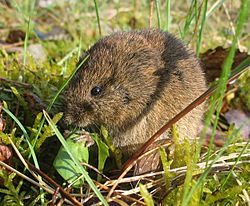Muroidea facts for kids
Quick facts for kids MuroidsTemporal range: Middle Eocene - Recent
|
|
|---|---|
 |
|
| Microtus arvalis | |
| Scientific classification | |
| Kingdom: | |
| Phylum: | |
| Class: | |
| Order: | |
| Superfamily: |
Muroidea
Illiger, 1811
|
| Families | |
|
Platacanthomyidae |
|
Muroids (scientific name: Muroidea) are a huge group of rodents. This group includes many animals you might know, like hamsters, gerbils, and true mice and rats. They also include many other animals that are related to these common rodents.
Muroids live almost everywhere on Earth, except for Antarctica. Scientists have found over 1300 different species of muroids! This makes them one of the largest and most successful groups of mammals.
Contents
What are Muroids?
Muroids are a special type of rodent. They are part of a very big superfamily. This means they are a large group of animals that are all closely related.
Scientists have divided muroids into 6 main families. These families are then split into 19 smaller groups called subfamilies. In total, there are about 280 different types of genera (groups of species) and at least 1300 different species of muroids.
Types of Muroids
The muroid superfamily is very diverse. Here are some of the main families and what animals they include:
Spiny Dormice and Pygmy Dormice
- Family Platacanthomyidae: This family includes the spiny dormouse and the pygmy dormice. They are a bit of a mystery to scientists, as their exact place in the muroid family tree is still being studied.
Digging Rodents
- Family Spalacidae: These muroids are known for living underground. They are often called "fossorial" animals because they are great at digging tunnels.
- Subfamily Myospalacinae: These are the zokors, which are rodents that look a bit like moles.
- Subfamily Rhizomyinae: This group includes bamboo rats and root rats. They also spend a lot of time underground.
- Subfamily Spalacinae: These are the blind mole rats. As their name suggests, they are blind and live entirely underground.
Typical Muroids
This large group, called Eumuroida, includes many of the muroids you might be most familiar with.
Mouse-like Hamsters
- Family Calomyscidae: This family contains just one type of animal, the mouse-like hamster. They look like a mix between a mouse and a hamster!
African Rodents
- Family Nesomyidae: Most of the animals in this family live in Africa or on the island of Madagascar.
- Subfamily Cricetomyinae: This group includes interesting animals like pouched rats and mice. They have cheek pouches, just like hamsters!
- Subfamily Dendromurinae: This subfamily has many types of mice, such as African climbing mice, gerbil mice, fat mice, and forest mice.
- Subfamily Mystromyinae: This group includes the white-tailed rat.
- Subfamily Nesomyinae: These are the Malagasy rats and mice, found only on Madagascar.
- Subfamily Petromyscinae: This group includes rock mice and the climbing swamp mouse.
Hamsters, Voles, and New World Rodents
- Family Cricetidae: This is a very large family with many well-known rodents.
- Subfamily Arvicolinae: This group includes voles, lemmings, and the muskrat. Voles and lemmings are small, furry rodents often found in grassy areas.
- Subfamily Cricetinae: These are the true hamsters, which are popular pets.
- Subfamily Neotominae: This subfamily includes many rats and mice found in North America.
- Subfamily Sigmodontinae: This is another large group of rats and mice, often called New World rats and mice.
- Subfamily Tylomyinae: This group also contains some New World rodents.
Old World Rats and Mice
- Family Muridae: This is the largest family of muroids, with many species found across the "Old World" (Europe, Asia, and Africa).
- Subfamily Deomyinae: This group includes spiny mice, brush-furred mice, and the link rat.
- Subfamily Gerbillinae: This is where you'll find gerbils, jirds, and sand rats. Gerbils are also popular pets.
- Subfamily Leimacomyinae: This subfamily contains only one species, the Togo mouse.
- Subfamily Lophiomyinae: This group includes the unique crested rat.
- Subfamily Murinae: This is a huge group that includes most of the common Old World rats and mice, like vlei rats.
Where to Learn More
If you want to dive deeper into the world of muroids, here are some of the scientific studies that help us understand them better:
- Steppan, S. J., R. A. Adkins, and J. Anderson. 2004. Phylogeny and divergence date estimates of rapid radiations in muroid rodents based on multiple nuclear genes. Systematic Biology, 53:533-553.
- Jansa, S. A. and M. Weksler. Phylogeny of muroid rodents: relationships within and among major lineages as determined by IRBP gene sequences. Molecular Phylogenetics and Evolution, 31:256-276.
- Michaux, J., A. Reyes, and F. Catzeflis. 2001. Evolutionary history of the most speciose mammals: molecular phylogeny of muroid rodents. Molecular Biology and Evolution, 17:280-293.
- Musser, G. G. and M. D. Carleton. 1993. Family Muridae. Pp. 501-755 in Mammal Species of the World a Taxonomic and Geographic Reference. D. E. Wilson and D. M. Reeder eds. Smithsonian Institution Press, Washington D.C.
- Norris, R. W., K. Y. Zhou, C. Q. Zhou, G. Yang, C. W. Kilpatrick, and R. L. Honeycutt. 2004. The phylogenetic position of the zokors (Myospalacinae) and comments on the families of muroids (Rodentia). Molecular Phylogenetics and Evolution, 31:972-978.
See also
 In Spanish: Muroidea para niños
In Spanish: Muroidea para niños

